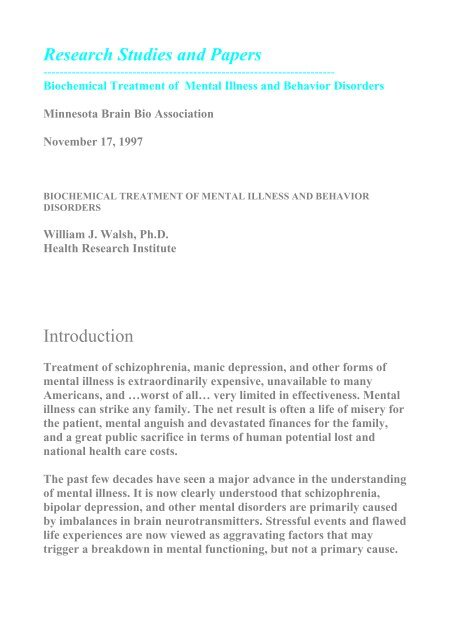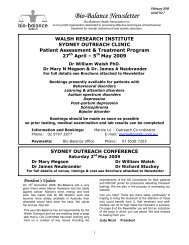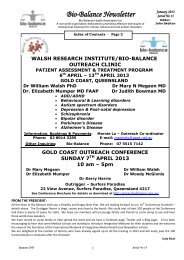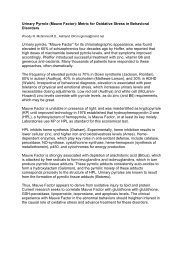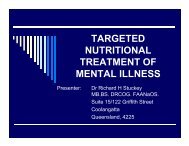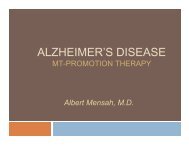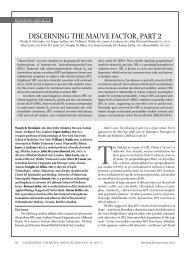Download PDF - Bio-Balance Health
Download PDF - Bio-Balance Health
Download PDF - Bio-Balance Health
- No tags were found...
Create successful ePaper yourself
Turn your PDF publications into a flip-book with our unique Google optimized e-Paper software.
This improved understanding has led to a revolution in the treatmentof mental illness. In place of the psychiatrist’s couch, the principalfocus is now adjustment of disordered brain chemistry through theuse of powerful drug medications. In the beginning, treatment wasoften more Edisonian than scientific with a variety of tranquilizers,neuroleptics, and other drugs applied on a trial-and-error basis. Inrecent years, "designer drugs" developed to alter the functioning ofspecific neurotransmitters, such as dopamine, serotonin, etc., havebeen introduced.Medication therapy has produced wonderful benefits for manyvictims of mental illness. However, these benefits are usually partial innature. In 1995, a typical patient with schizophrenia undermedication may be able to live without institutionalization, butusually is only a shadow of his/her former self in terms of cognitivefunction, behavioral control, and peace of mind.Limitations of Medication TherapyAny medication aimed at a specific neurotransmitter will inevitablyalter some of the dozens of other neurotransmitters. The net result islikely to be changes in behavior or other side effects. We should notexpect that a powerful psychiatric medication will have effectivenesswithout some unwanted alteration of brain function. Moreover,schizophrenia, bipolar depression, and other mental disorders are notsingle illnesses but a diverse collection of disorders, each withdifferent biochemistry. Thus any single drug may have strikinglydifferent outcomes for different patients.The development of new psychiatric drugs will not conquer mentalillness, but will instead place additional weapons in the arsenal of thepractitioner. Since mental illnesses are diverse and individual patientsare biochemically unique, a larger number of candidate drugs willincrease the likelihood of finding a beneficial medication (orcombination of medications). Thus in future times, psychiatricpatients will probably have medications with improved effectiveness
and fewer side effects. However, it is likely that these patients will stillsuffer from residual mental illness and experience side effects.The ultimate remedy for mental illness may not be a collection of drugmedications aimed at adjusting neurotransmitters. Advances inmolecular biology and brain chemistry will eventually identify thebasic causes and mechanisms of chemical imbalances, which may leadto more direct (and more natural) methods of adjustingneurotransmitters.<strong>Bio</strong>chemical TreatmentThe brain is a chemical factory that constantly producesneurotransmitters throughout our lives. The raw materials are aminoacids, vitamins, minerals, and other nutrients. The step-by-stepprocesses by which the body produces the major neurotransmittershave been known for years.Sufficient nutrients to produce neurotransmitters can usually beobtained from a well-balanced diet involving the major food groups.However, many persons have absorption or metabolic disorderswhich result in severe nutrient imbalances that adversely affect brainfunctioning. For example, animal studies (Dakshinamurti, et.al.) haveshown that a diet low in vitamin B-6 can result in reduced serotoninlevels in the brain. This is not surprising since B-6 is a vital cofactorrequired for natural synthesis of serotonin.It would be a simple matter if all nutrient imbalances weredeficiencies, since a multiple vitamin/mineral supplement would thenhave efficacy. Unfortunately, most imbalances involve overloads ofcertain nutrients, and multiple vitamin/mineral supplements canmake these persons worse. For example, elevated copper has beenassociated with paranoia (Pfeiffer and Iliev), and high folate levelshave been observed in obsessive-compulsive schizophrenics (Pfeiffer,et.al.).
<strong>Bio</strong>chemical treatment is a modality in which nutrient levels in blood,urine, and tissues are balanced to improve physical and mentalfunctioning. The procedure involves extensive chemical analysis ofblood, urine, and tissues to define the patient’s biochemistry.Treatment requires supplements of specific amino acids, vitamins,and minerals which need to be supplied with rifle-shot precision.<strong>Bio</strong>chemical treatment can be effective only for persons withsignificant biochemical imbalances. This new therapy has beenapplied primarily to victims of schizophrenia, depression, andbehavior disorders.<strong>Bio</strong>chemical Treatment of SchizophreniaIn the 1950’s, Abram Hoffer discovered that many persons withsevere mental illness improved greatly after treatment with vitaminsB-3, B-12, and folic acid. Subsequently, Carl Pfeiffer, M.D., Ph.D. ofPrinceton, New Jersey, developed a classification system whichdivided schizophrenia into three major biochemical groupings whichhe termed histadelia, histapenia, and pyroluria. Pfeiffer studied morethan 20,000 patients with schizophrenia and reported 90% of themfell into one of these three categories. He developed individualizednutrient treatments for each of these conditions and reported goodtreatment effectiveness across each group. Pfeiffer (now deceased)reported striking improvements in thousands of case histories, butunfortunately did not carry out double-blind, controlled studies oftreatment efficacy. In the absence of double-blind studies, thispromising treatment system has been regarded as unproved.The Pfeiffer Treatment Center (Naperville, IL) has treated more than1,000 persons with a diagnosis of schizophrenia using this system. Anoutcome study involving 150 patients indicated that best results areachieved for patients under the age of 40. Referring psychiatristsreport that most patients improve significantly after biochemicaltreatment, enabling lower medication dosages and reduced sideeffects. <strong>Bio</strong>chemical treatment for schizophrenia is most effectivewhen administered along with medication, counseling and otherconventional treatment. At the present state of development,
iochemical treatment usually does not result in complete freedomfrom medication for persons with severe mental illness.<strong>Bio</strong>chemical Treatment of DepressionThe Pfeiffer Treatment Center has observed that most victims ofdepression fall into one of five biochemical classes: (1) high histamine,(2) low histamine, (3) pyroluric, (4) high copper, and (5) toxicoverload. The treatment for these biochemical disorders is highlyindividualized, with most patients reporting good treatmenteffectiveness.High-histamine depressives overproduce and retain excessive levels ofhistamine, an important neurotransmitter which affects humanbehavior. They are under-methylated resulting in generalized lowlevels of important neurotransmitters such as serotonin. Thissyndrome often involves seasonal variations in depression, obsessivecompulsivebehavior, inhalant allergies, and frequent headaches.<strong>Bio</strong>chemical treatment revolves around antifolates, especially calciumand methionine. Three to six month of nutrient therapy are usuallyneeded to correct this chemical imbalance. As in most biochemicaltherapies, the symptoms usually return if treatment is stopped.Low-histamine depressives are usually nervous, anxious individualswho are prone to paranoia and despair. They are over-methylatedwhich results in elevated dopamine and norepinephrine levels.Although free of seasonal allergies, they often report a multitude offood and chemical sensitivities. Many have a history of hyperactivity,learning disabilities, and underachievement. Treatment focuses on useof folic acid together with niacinamide and vitamin B-12, with about2-4 months required for correction of the imbalance.Pyroluria is a stress disorder characterized by pronounced moodswings, temper outbursts, and anxious depression. Many pyroluricsreport an inability to eat breakfast, absence of dream recall, andfrequent infections. Treatment centers on correcting a doubledeficiency of B-6 and zinc, which is believed to result from abnormalhemoglobin synthesis that depletes the body of these nutrients. A
positive response often occurs within the first 7 days of treatment,with 1-2 months usually required for correction of the imbalance.High-copper depressives usually have a history of hyperactivity,tinnitus, and skin sensitivity to metals. Females with this conditionusually have significant PMS and are prone to heightened depressionduring hormonal events such as childbirth and menopause. Theyoften report a worsening of depression after estrogen or multiplevitamins. Treatment focuses on release of excess copper from tissues,promotion of copper excretion, and stimulation of metallothionein (ametal-binding protein). Caution must be exercised due to the tendencyof blood copper levels to rise during the first 10 days of treatment.Many patients report a mild worsening over the first 3 weeks,followed by steady improvement. A total of 60 to 90 days is usuallyrequired to correct this imbalance.Toxic substances which are capable of producing depression includelead, cadmium, mercury, and a wide variety of organic and inorganicchemicals. This syndrome often involves a sudden, prolonged bout ofdepression without apparent reason and without a prior history ofdepression. Treatment varies with the type of toxic material involved,and care must be exercised to avoid flooding the kidneys with toxinsduring the early stages of treatment. Heavy-metal overloads can becorrected quickly by in-hospital chelation, or more slowly usingbiochemical treatment. Organic chemical overloads require liberaluse of antioxidants along with avoidance of the offending substances.In an outcome study of 200 depressive patients treated at the PfeifferTreatment Center, approximately two-thirds reported their antidepressantmedications were no longer necessary after biochemicaltreatment. However a double-blind, controlled study is needed tobetter define treatment efficacy.<strong>Bio</strong>chemical Treatment of Behavior DisordersIn the late 1970’s, Dr. Walsh and co-workers developed a biochemicalclassification system for behavior disorders based on trace-metal
concentrations. Based on chemical analysis data from hundreds ofviolent criminals and behavior-disordered children, behaviordisorders were divided into four distinct types.Type A individuals are characterized by an elevated copper/zinc ratio,along with elevated lead and cadmium and low sodium and potassiumlevels. They exhibit episodic rages which may be quite violent, andusually exhibit remorse after they have calmed down. Patrick Sherrillwho killed 17 co-workers in an Oklahoma post office was found tohave a severe Type A imbalance. Many school children who are TypeA individuals may have mild, moderate, or severe versions of thischemical imbalance.Type B individuals are characterized by low copper/zinc ratios, alongwith elevated sodium, potassium, lead and cadmium. Most exhibitbehavior disorders by age 2, and are often described as oppositional,defiant, pathological liars, remorseless, and cruel. The incidence of theType B imbalance appears to be less than 0.5% in the generalpopulation, but between 20-75% in maximum-security prisons inIllinois, California, and Ohio. In studies of ex-convicts and violentchildren, Dr. Pfeiffer found these individuals to exhibit elevated bloodhistamine, low blood spermine, elevated kryptopyrroles in urine, andzinc deficiency. Notable examples of persons with a severe Type Bimbalance include James Huberty (McDonalds massacre), serial killerHenry Lee Lucas, and Charles Manson.Type C individuals are low in most nutrients and Dr. Pfeifferidentified their primary imbalance to be malabsorption. The majorityare slender, non-violent, impulsive persons who underachieve inschool and in the workplace.Type D persons were found by Dr. Pfeiffer to exhibit glucose-controlproblems. These individuals are often non-violent underachievers whocomplain of irritability, fatigue, and sugar cravings.The <strong>Health</strong> Research Institute (parent organization of the PfeifferTreatment Center) has accumulated a data base of chemistry levelsfor more than 6,500 behavior-disordered children, 800 violent
criminals, and 26 serial killers and mass murderers. We have foundthat about 90% of these persons fit into one of the A/B/C/D categories.In the early 1980’s, Dr. Pfeiffer developed individualized biochemicaltreatments for each of these behavior syndromes. Under this system,patients are screened and treated for trace-metal imbalances,histamine disorders, pyroluria, malabsorption, glucose disorders, andother biochemical imbalances. Nearly 7,000 behavior-disorderedpersons have been treated at the Pfeiffer Treatment Center using thissystem. In four separate outcome studies involving a total of 1,400patients, a majority of the families reported major improvements inbehavior control after biochemical treatment. These studies indicatedgood treatment effectiveness for most patients below the age of 14.In a blinded, controlled study in 1992, 24 patients of the PfeifferTreatment Center were tested before and after 4 months ofindividualized biochemical treatment by an independent testingexpert. The test group showed clear improvements in behavior controlafter treatment, whereas controls did not.Our nation’s problems of crime and violence will not be solved bygetting tough with criminals, building more prisons, or widerapplication of the death penalty. The only hope is early identificationof behavior-disordered children and effective treatment. <strong>Bio</strong>chemicaltherapy represents a promising approach to this societal problem.SUMMARY<strong>Bio</strong>chemical treatment, originally developed for schizophrenia, hasalso shown promise in the treatment of depression and behaviordisorders. Although still in a process of evolution, the testing methodsand treatment modalities have matured to the point that a highpercentage of patients report treatment effectiveness. However,double-blind, placebo-controlled studies must be successfully carriedout before this promising therapy can become part of mainstreammedicine.
------------------------------------------------------------------------<strong>Health</strong> Research Institute Pfeiffer Treatment Center HRI Pharmacy4575 Weaver Parkway - Warrenville, IL 60555-4039(630) 505-0300 - (630) 836-0667 faxQuestions or Comments:info@HRIPTC.org| Home Page | Services | Pharmacy | Research | Education | Patient Info | Directions |All contents Copyright (c) 200 <strong>Health</strong> Research Institute. All rights reserved.4HRI is a Not-for-Profit 501c3.


